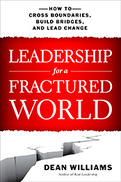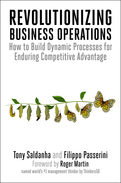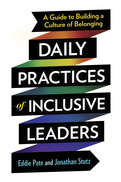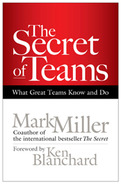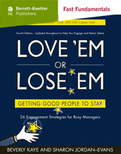Search Results: "building resilience"
Results 43-48 of 463
Leaders today—whether in corporations or associations, nonprofits or nations—face massive, messy, multidimensional problems. No one person or group can possibly solve them—they require the broadest possible cooperation. But, says Harvard scholar Dean Williams, our leadership models are still essentially tribal: individuals with formal authority leading in the interest of their own group. In this deeply needed new book, he outlines an approach that enables leaders to transcend internal and external boundaries and help people to collaborate, even people over whom they technically have no power.
Drawing on what he's learned from years of working in countries and organizations around the world, Williams shows leaders how to approach the delicate and creative work of boundary spanning, whether those boundaries are cultural, organizational, political, geographic, religious, or structural. Sometimes leaders themselves have to be the ones who cross the boundaries between groups. Other times, a leader's job is to build relational bridges between divided groups or even to completely break down the boundaries that block collaborative problem solving. By thinking about power and authority in a different way, leaders will become genuine change agents, able to heal wounds, resolve conflicts, and bring a fractured world together.
Drawing on what he's learned from years of working in countries and organizations around the world, Williams shows leaders how to approach the delicate and creative work of boundary spanning, whether those boundaries are cultural, organizational, political, geographic, religious, or structural. Sometimes leaders themselves have to be the ones who cross the boundaries between groups. Other times, a leader's job is to build relational bridges between divided groups or even to completely break down the boundaries that block collaborative problem solving. By thinking about power and authority in a different way, leaders will become genuine change agents, able to heal wounds, resolve conflicts, and bring a fractured world together.
Dig Your Heels In
2019
Joan Kuhl helps women create a clear vision of what their career path deserves to be and make a convincing business case for equality to their managers and senior leadership. You'll learn strategies for overcoming sexist cultural attitudes about gender and leadership, as well as for dealing with self-limiting behaviors like Imposter's Syndrome (the feeling that you're never good enough despite a track record of success) and the Myth of Meritocracy (the idea that just doing good work is the only way to advance). Because relationships are absolutely crucial, Kuhl describes how to build support networks before you even need them and explains how to get actionable feedback that will help you get to the next level—the kind women rarely are afforded.
Case studies, practical exercises, and inspiring stories from Kuhl's work with clients at companies such as Eli Lilly and Company, Goldman Sachs, U.S. Soccer, BlackRock, South Carolina Asphalt Pavement Association and top business schools make this a truly comprehensive guide. It's an indispensable resource for women seeking to build the confidence and conviction to secure the seat at the table they've earned and create a welcoming workplace for everyone.
Case studies, practical exercises, and inspiring stories from Kuhl's work with clients at companies such as Eli Lilly and Company, Goldman Sachs, U.S. Soccer, BlackRock, South Carolina Asphalt Pavement Association and top business schools make this a truly comprehensive guide. It's an indispensable resource for women seeking to build the confidence and conviction to secure the seat at the table they've earned and create a welcoming workplace for everyone.
Don't risk the dire consequences of your work processes becoming obsolete-discover a powerful model for constant, ongoing, enterprise-wide process evolution and optimization.
If you have a great product, but don't have the operations in place to efficiently and effectively support it-production, manufacturing, sales, finance, human resources, etc.-you won't succeed. Product innovation is seen as flashier and so gets far more attention, but you can create an enduring competitive advantage by revolutionizing business operations.
The problem is most attempts to improve business operations are reactive, sporadic, and siloed. Tony Saldanha and Filippo Passerini's Dynamic Process Transformation model provides a living model for constant, ongoing process evolution and optimization.
The authors focus on maximizing three drivers of change. First, open market rules-each business process must be run as a separate business, instead of via monolithic mandates coming down from on high. Second, there must be unified accountability- outcomes must be clear and consistent across the company, instead of being siloed within departments. And third, there needs to be a dynamic operating engine, a methodology to convert the constantly changing business process goals into tactical day-to-day employee actions.
With numerous examples from leading companies, this book shows how to proactively keep business processes across the company from becoming obsolete and take advantage of a neglected key to success.
If you have a great product, but don't have the operations in place to efficiently and effectively support it-production, manufacturing, sales, finance, human resources, etc.-you won't succeed. Product innovation is seen as flashier and so gets far more attention, but you can create an enduring competitive advantage by revolutionizing business operations.
The problem is most attempts to improve business operations are reactive, sporadic, and siloed. Tony Saldanha and Filippo Passerini's Dynamic Process Transformation model provides a living model for constant, ongoing process evolution and optimization.
The authors focus on maximizing three drivers of change. First, open market rules-each business process must be run as a separate business, instead of via monolithic mandates coming down from on high. Second, there must be unified accountability- outcomes must be clear and consistent across the company, instead of being siloed within departments. And third, there needs to be a dynamic operating engine, a methodology to convert the constantly changing business process goals into tactical day-to-day employee actions.
With numerous examples from leading companies, this book shows how to proactively keep business processes across the company from becoming obsolete and take advantage of a neglected key to success.
True inclusion happens when leaders stop relying on HR practitioners to own full responsibility for DEI initiatives. The small, intentional daily leadership practices in this book are the key to creating truly inclusive organizations.
Diversity and inclusion training and books have flooded the market, but the gap between what is promised and what is delivered is beginning to undermine the progress that has been made.
There are millions of people who strive to make a difference in workplace diversity and inclusion. And with this practical, leader-friendly framework, Daily Practices of Inclusive Leaders will equip readers with the actionable tools they've been searching for.
Leaders will learn:
● Why they are the key to inclusion
● Insights for the lifelong journey
● Successful practices they can start today
● And more
With the era of big DEI coming to an end, leaders will make big strides through small daily changes in their processes that lead to creating an inclusive workplace culture. With this toolkit of actions, activities, and tactics leaders will become the foundation of diversity and inclusion in their organization.
Diversity and inclusion training and books have flooded the market, but the gap between what is promised and what is delivered is beginning to undermine the progress that has been made.
There are millions of people who strive to make a difference in workplace diversity and inclusion. And with this practical, leader-friendly framework, Daily Practices of Inclusive Leaders will equip readers with the actionable tools they've been searching for.
Leaders will learn:
● Why they are the key to inclusion
● Insights for the lifelong journey
● Successful practices they can start today
● And more
With the era of big DEI coming to an end, leaders will make big strides through small daily changes in their processes that lead to creating an inclusive workplace culture. With this toolkit of actions, activities, and tactics leaders will become the foundation of diversity and inclusion in their organization.
The Secret of Teams
2011
Teams are critical to the success of every organization. Departmental, interdepartmental, cross-functional, ad hoc, task-specific—teams do everything from planning the office party to setting the annual budget to establishing performance goals.
But what separates the teams that really deliver from the ones that simply spin their wheels? What is the secret of high-performance teams?
As he did in The Secret, Mark Miller uses a compelling business fable to reveal profound yet easily grasped truths that can dramatically transform any organization. Debbie Brewster, the heroine of The Secret, has been promoted and is now struggling with taking her new team to the next level. Her old mentor, Jeff Brown, the company's CEO, sends her out to find the secret of teams. On her journey she learns from three very different teams—the Special Forces, NASCAR, and a local restaurant.
Debbie and her team discover the three elements that all successful teams have in common. But that's just the beginning. The devil is in the details, as the story of Debbie's efforts to actually implement the three elements shows. You'll learn how to change entrenched ways of thinking and acting, what you have to do to optimize each of the three elements of a successful team, how to measure your progress, and more.
Creating high-performance teams does more than just give your organization a competitive advantage. It can be a performance multiplier that significantly improves results while honoring and developing people. It may be the ultimate win-win-win that your organization is seeking.
But what separates the teams that really deliver from the ones that simply spin their wheels? What is the secret of high-performance teams?
As he did in The Secret, Mark Miller uses a compelling business fable to reveal profound yet easily grasped truths that can dramatically transform any organization. Debbie Brewster, the heroine of The Secret, has been promoted and is now struggling with taking her new team to the next level. Her old mentor, Jeff Brown, the company's CEO, sends her out to find the secret of teams. On her journey she learns from three very different teams—the Special Forces, NASCAR, and a local restaurant.
Debbie and her team discover the three elements that all successful teams have in common. But that's just the beginning. The devil is in the details, as the story of Debbie's efforts to actually implement the three elements shows. You'll learn how to change entrenched ways of thinking and acting, what you have to do to optimize each of the three elements of a successful team, how to measure your progress, and more.
Creating high-performance teams does more than just give your organization a competitive advantage. It can be a performance multiplier that significantly improves results while honoring and developing people. It may be the ultimate win-win-win that your organization is seeking.


